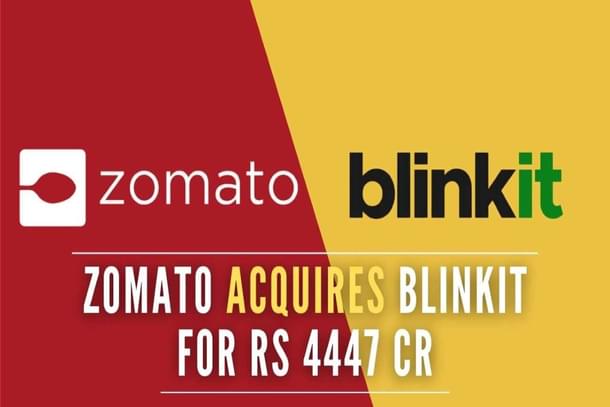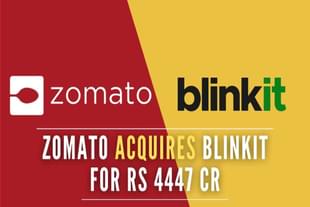Commentary
Will Zomato-Blinkit Deal Work Out Despite Scepticism Over Valuation And Cash Burn?
Business Briefs
Jun 25, 2022, 07:44 PM | Updated 07:43 PM IST
Save & read from anywhere!
Bookmark stories for easy access on any device or the Swarajya app.


After the news of Zomato's merger with Blinkit for Rs 4,447 crores, several social media handles expressed their surprise and scepticism about the deal. Though the Zomato-Blinkit deal has been in the offing for a while, the official decision was taken during a board meeting on Friday.
The acquisition would involve the issue of new shares worth Rs 4,447 crores, creating an equity dilution of 6.88 per cent. The mainstay business Blinkit Commerce Private Limited (BCPL) would be acquired for Rs 4,447.5 crores, cutting its valuations by half. Blinkist's subsidiary Hands-on Trades Private Limited's (HOTPL) warehousing and ancillary services business would be acquired for another Rs 60.7 crores, to be paid in cash.
Zomato's Perspective
Zomato had been an investor in Grofers, the name under which Blinkit previously operated as a grocery delivery company. It owned 9 per cent of Blinkit even before the acquisition through its previous investments in the quick-commerce players.
According to Zomato, both food delivery and quick-commerce are hyper-local businesses. Hence, having the platforms operate under the same umbrella would help the companies increase their share of the customer's wallet. In addition, it expects to have higher frequency and engagement from customers after the acquisition.
Zomato's release also contains data from Blinkit that signals a shift towards unplanned and spontaneous purchases – which indicates that quick-commerce is becoming more preferable to next-day delivery. For instance, the percentage of weekly user retention has jumped by 1.6 times between the first and fourth quarters of the financial year 2022 after Blinkit's pivot to quick-commerce.
In addition, Blinkit's gross order value has already grown by 471 per cent over the last 14 months. According to Zomato, the shift towards quick commerce is not dictated by the discounting which has come down recently but is an organic shift.
Though the Blinkit brand and app will operate separately from Zomato, its CEO Deepinder Goyal has suggested that they would look at various ways to explore synergies between the platform.
But despite the positives about the acquisition highlighted by Zomato, why are sceptics still concerned?
The Cash Burn Continues.
Both Zomato and Blinkit are loss-making businesses and are still burning cash to run their operations. Zomato reported a cash burn of Rs 693 crores for FY22, which has come down from a burn of Rs 1017.9 crores for FY21. While Zomato's earnings before interest, taxes, depreciation and amortization (EBITDA) margins have increased from -153 per cent in FY18 to -18 per cent in FY22, the business still remains unprofitable.
Blinkit had reported revenues of Rs 2,700 crores and losses of Rs 6,127 crores for FY21. Further, Zomato is still unsure about Blinkit's profitability timeline – with the team sharing an "educated guess" but not a "guidance".
Zomato says that Blinkit could break even on adjusted EBITDA terms in less than three years. But even then, there is no guarantee that the cash burn period will be over. If reports are to be believed, Blinkit has already faced a cash crunch, shut down several dark stores, and laid-off employees. It is widely believed that Blinkit's cash burn had accelerated after its pivot into quick commerce.
In order to save Blinkit from shutting down, Zomato had previously extended a loan of Rs 1125 crores to Blinkit. Further, Zomato plans to potentially allocate another Rs 1,875 crores to the quick delivery business from its own cash balance. Effectively, the acquisition would cost almost Rs 7,400 (Rs 4500 in stock plus the Rs 2900 crores of additional investments), taking into consideration the additional investments planned by Zomato. Clearly, the investments are quite huge for a business that has been struggling for a while.
Others have expressed concerns over the numbers supplied by Zomato. For instance, Blinkit's total orders placed numbers include cancelled orders as well. Further, the numbers supplied in the release are unaudited numbers that were received directly from Blinkit. It also appears that the number used for Blinkit's GOV is based on the maximum retail price, rather than being adjusted for the discounts applied on the order.
"GOV is defined as the total monetary value of Orders including maximum retail price (MRP) of goods sold (except for instances where MRP is not applicable such as fruits and vegetables in which case final selling price is used instead of MRP) and customer delivery charges but excluding tips," said Zomato's release.
Apart from internal issues, Blinkit continues to face competition from other quick commerce start-ups backed by deep-pocketed entities, making it tougher for the company to become profitable.
Deal Valuation and Dilution Remain Concerns
Given Blinkit's lack of profitability, it becomes difficult for even the smartest of analysts to value the business since the cost structure of the profitable entity could be difficult to estimate. Given the large range of scenarios of how the business's revenue and cost structure could finally end up looking, the valuations at which Blinkit was acquired remain a concern.
The Blinkit all-stock deal would dilute the equity base by around 6.88 per cent, which is fairly significant - especially in the light that the deal involves the acquisition of a business that is expected to burn cash over the next few years.
Zomato's public investors have already been struggling after the stock price almost halved since it listed on the bourses.
Zomato's investors could face another dilution in case Zomato is unable to turn profitable. In that case, Zomato would have to raise money from investors once again, diluting the shareholding of public investors once again. So far, Zomato has denied any plans to raise more capital to become profitable and believes that no other equity dilution would be necessary.
Despite the negatives, the data provided by Zomato has suggested that people have developed or are developing habits of spontaneous grocery/essential purchases. In addition, its core business has shown several metrics of improvement as well. Whether these translate into profits and a significant return on capital employed remains to be seen.





